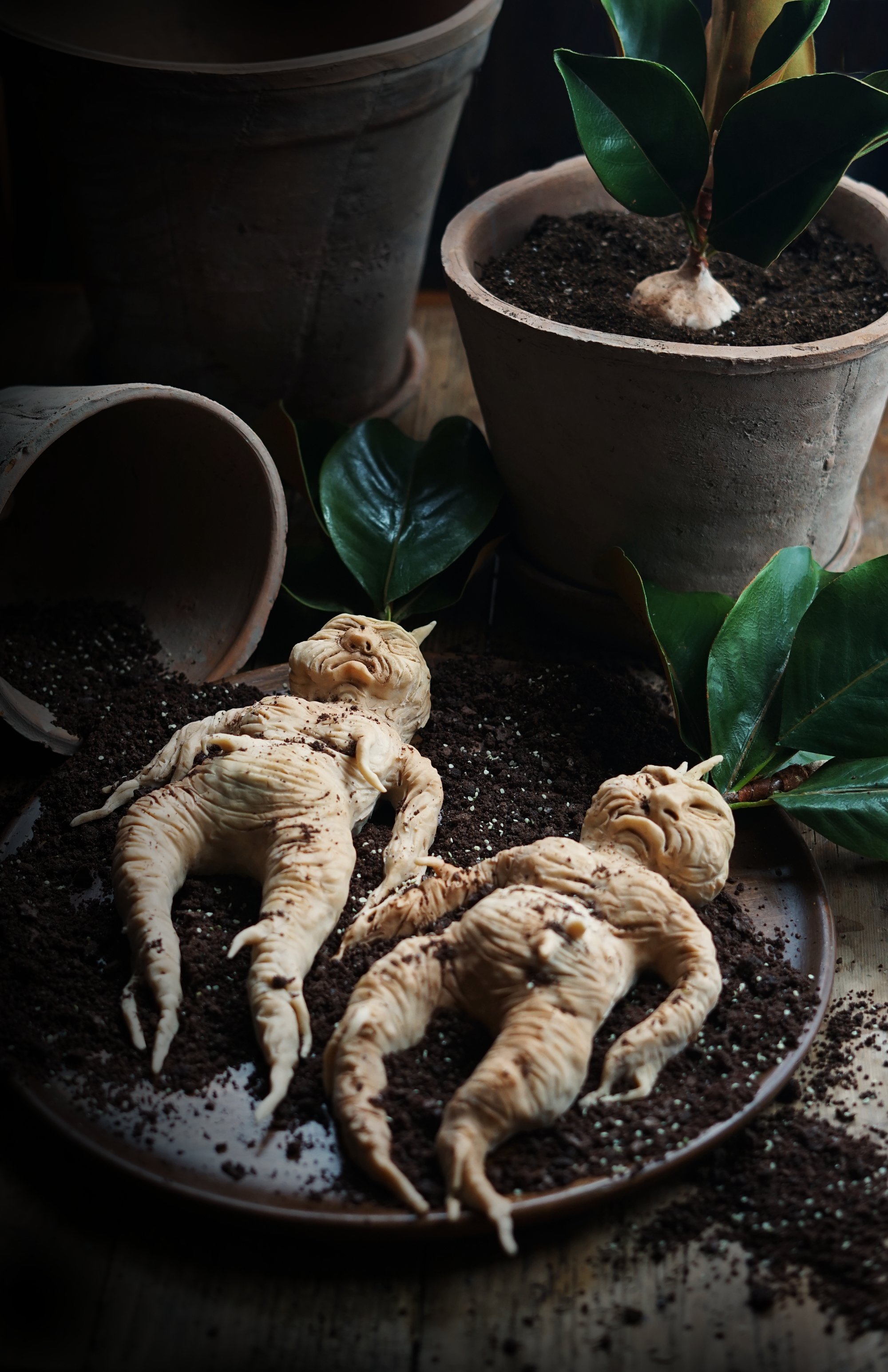Secret Recipe: Chicory Caramel Mandrakes
New to foraging? Learn more about ethical and safe foraging (plus how to get started) here!
Imagine a plant with a root shaped like a human, that emits an ear-splitting (and sometimes fatal) scream when uprooted. Mandrakes are best-known today for their appearance in the Harry Potter books and films, but they’re a real plant that’s been used for centuries in mystical practices and magical preparations.
A mandrake is the root of a plant that takes an odd human-like form and has been said to possess certain mystical or metaphysical powers.They are generally said to be derived from plants of the genus Mandragora, which are “perennial herbaceous plants with ovate leaves arranged in a rosette, a thick upright root, often branched, and bell-shaped flowers followed by yellow or orange berries.” (according to Wikipedia: https://en.wikipedia.org/wiki/Mandrake)
Real mandrakes contain constituents that can lead to delirium and hallucinations, and have been associated with many superstitious practices both for those effects and their resemblance to human figures. They’ve played a part in many magic rituals over the centuries of use. The active alkaloids in the plant make it poisonous, causing everything from hallucinogenic and hypnotic effects to asphyxiation or even death. It’s been used as an anesthetic for surgery in ancient times and was also used to treat a variety of other medical conditions at small doses, while in large doses it was said to excite madness. (Or, you know, kill you…)
One legend of mandrake tells that the roots themselves are said to bring good fortune, but people who pull up the root will be condemned to hell as the root emerges, screaming, from the ground. Some old texts contain complex directions for how to harvest it safety. For example, Josephus of Jerusalem (in circa 37-100AD) gives the following directions:
“A furrow must be dug around the root until its lower part is exposed, then a dog is tied to it, after which the person tying the dog must get away. The dog then endeavours to follow him, and so easily pulls up the root, but dies suddenly instead of his master. After this, the root can be handled without fear.”
(Sacrificing a dog for a root? Sounds pretty heartless to me.)
The following is taken from Jean-Baptiste Pitois' The History and Practice of Magic:
“Would you like to make a Mandragora, as powerful as the homunculus (little man in a bottle) so praised by Paracelsus? Then find a root of the plant called bryony. Take it out of the ground on a Monday (the day of the moon), a little time after the vernal equinox. Cut off the ends of the root and bury it at night in some country churchyard in a dead man's grave. For 30 days, water it with cow's milk in which three bats have been drowned. When the 31st day arrives, take out the root in the middle of the night and dry it in an oven heated with branches of verbena; then wrap it up in a piece of a dead man's winding-sheet and carry it with you everywhere.”
Sounds a bit complicated, no?
Some legends tell that mandrakes spring from the dripping fluids of a hanged man; the scream that it emits when being pulled from the ground is the scream of their painful death.
Others claim that the rumors of the mandrake’s scream were perpetuated by witches or sorcerers attempting to protect the plant from common folk. It was an important and valuable plant to many spiritual practices, so it warranted protection by way of fearful legends. With the arrival of Christianity, practices relying on traditional herbs and plants were labeled demonic and had to be practiced under cover to avoid persecution.
The evil nature of mandrakes was also perpetuated in various works of literature, including Shakespeare. The plant holds a starring role in Shakespeare's Romeo and Juliet: "What with loathsome smells, And shrieks like mandrakes torn out of the earth, That living mortals, hearing them, run mad."
But once you obtain a mandrake root, what to do with it? There seemed to be as many uses as there were dark rumors about these plants. From fertility aids (such as in the Bible’s Book of Genesis or in Greek Mythology tales about Circe and Aphrodite) to full-body control, the mandrake was seen as immensely powerful. Once the medieval doctrine of signatures came along, more legends about the mandrake came into circulation. This doctrine claimed that plants that resembled certain body parts could be used to heal them (for example, walnuts were said to both resemble and cure the brain), so the body-resembling mandrake plant was said to have complete control over the body. This made it a powerful plant indeed, especially when coupled with its narcotic and poisonous properties.
Mandrakes were used also in potions and spells for any number of different outcomes: fertility, love, wealth, power, health, wellness, etc. In Harry Potter, they are used in a restorative draught to revive all of the students who’d been petrified by the basilisk, a large snake with the capability to turn anyone who sees a reflection of its eyes to stone.
Few plants have such a dark and mottled history as the mandrake. From rumors of their origins coming from the bodily fluids of hanged men to their soul-cursing shrieks, mandrakes have captured both our fear and attention for much of human history. It’s no wonder that they are known today as a fantasy creation, rather than a real plant whose roots stretch back deep into human history. They are a reminder that all plants deserve attention and respect, but especially ones as powerful as the mandrake.
Find the rest of this post and the Secret Recipe over on Patreon.com/thewondersmith!
Huge thanks to my Patrons that make sharing all of these lovely posts with you possible (without all of the pop-ups and ads that make browsing other blogs so annoying). If you’re feeling generous, you too can support the wonder with a monthly contribution of your choice. Even $1 helps a lot! Your donation will help to fund this blog as well as my surprise free events and gifts for strangers. Learn more about this program at the link below:
Love what you’ve read here? Don’t forget to Subscribe to get frequent updates of new posts!



















Join me for a little winter night magic as we bake this cake full of rich seasonal flavors and black cocoa!